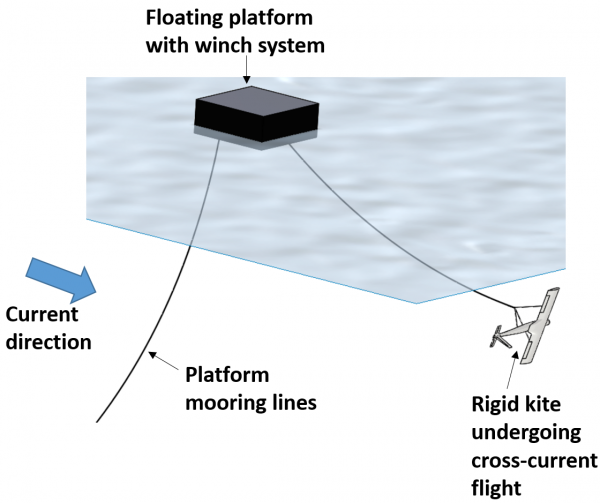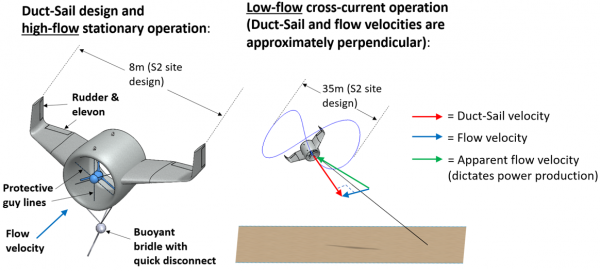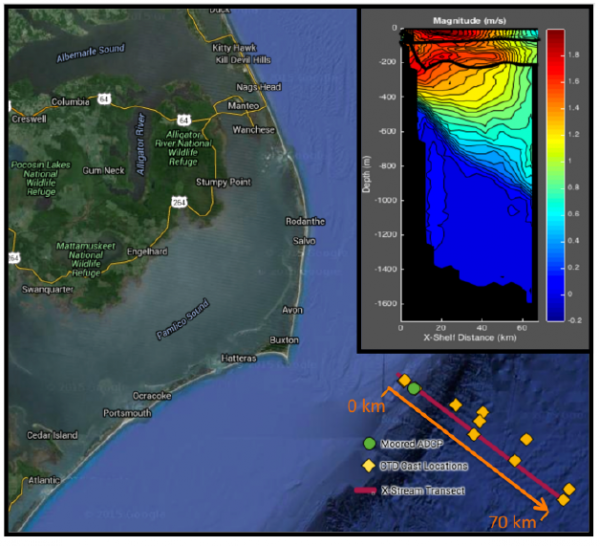Marine Hydrokinetic Energy Systems
Optimal Design and Control of Energy-Harvesting Underwater Kites
Tidal and ocean energy systems are burdened by large installation and manufacturing costs per unit of mass. Consequently, any measure that can dramatically increases power per unit mass can play a significant role in increasing the viability of tidal and ocean current energy systems. The CORE Lab is pioneering kite-based designs that execute power-augmenting cross-current motion perpendicular to the prevailing flow, producing more than an order of magnitude more power per unit wing area than the corresponding power per unit rotor area achieved by a fixed turbine. Furthermore, the replacement of the traditional tower with a tether reduces significant foundation and tower costs, which become prohibitive in deep waters such as the Gulf Stream. In collaboration with several colleagues at NC State and partner institutions (University of Maryland, NC Coastal Studies Institute, and Florida Atlantic University), the CORE Lab is leading the device design, control design, and scaled prototyping of several concepts. The scaled prototyping includes three phases, which constitute progressively more realistic test environments: (i) a water channel testing phase (completed), (ii) a pool-based tow testing phase (completed during spring/summer, 2021), and (iii) an open-water tow testing phase (completed at 1/10-scale in fall-winter, 2021-2022, with further 3/8-scale testing scheduled for fall, 2022). Shown below is a conceptual ocean kite and a video montage of initial experiments on a unique kite design that incorporates features of both kites and power-augmenting ducts, known as the Duct-Sail.

Conceptual underwater kite schematic (deployed off of a floating platform).
Example closed-loop cross-current control of an instrumented kite in the NC State pool.

Concept of operations for the Duct-Sail (specified dimensions will produce >30 kW in 1 m/s flow speed) and capacity factors of 70 percent in several tidal sites.
Initial pool-based tow testing of a trimmable Duct-Sail (a hybrid concept that fuses features of a power-augmenting high-lift duct with power-augmenting cross-current kite motion). Stay tuned for closed-loop cross-current flight control videos.
Ocean Current Turbine Array Dynamic Modeling, Layout Optimization, and Optimal Control
The portion of the Gulf Stream adjacent to the state of North Carolina possesses a consistent 2 m/s flow speed and more available power than the total power demand of the entire state. While it is impractical to harvest all of this energy, the Gulf Stream nevertheless presents a great deal of potential for enhancing North Carolina’s renewable energy portfolio.
One mechanism for harnessing Gulf Stream energy is through the deployment of tethered ocean current turbines (OCTs), an example of which is depicted below. Because OCTs will be tethered in a deep environment where the near-surface shear rate is low, there is an opportunity to vary the horizontal and vertical spacing of OCTs to optimize power. The research being conducted in the CORE Lab is focused on the development of advanced optimization techniques for optimizing the 3D spacing of OCTs in a way that is scalable to large arrays. Specifically, rather than optimizing the 3D position of each turbine in the array (a total of 3N design variables, where N is the number of turbines in the array), the framework being developed characterizes the 3D array configuration as a weighted sum of a small number of parameterized basis patterns. These basis patterns are simple geometric configurations (e.g., rectangular, staggered, etc.) that can be combined to form a wide variety of 3D configurations. The basic schematic of the OCT design being considered is shown below.

Schematic of the OCT design under consideration (left – this is the DOE Reference Model 4) and the basic design variables to be optimized (where the x, y, z positions of each OCT will be by-products of the computationally-simpler optimization detailed above).
Relocatable, Energy-Harvesting Autonomous Underwater Vehicles
While the Gulf Stream possesses a consistent 2 m/s flow speed, the location of this flow speed (termed the “Gulf Stream Jet”) varies over time by as much as 40 km horizontally and also exhibits substantial vertical variation (see the figure below, which illustrates the spatial variation). Thus, a stationary ocean current turbine is unlikely to be able to harness nearly the quantity of energy that could be harnessed by “chasing” this meandering Gulf Stream jet. Because of this reality, the CORE Lab is collaborating with NC State and the UNC Coastal Studies Institute to develop an architecture and underlying control system for an Autonomous Underwater Vehicle (AUV) that can autonomously select between multiple candidate cross-stream mooring locations. Ideally, the AUV will relocate itself in such a way that it remains in, or very close to, the Gulf Stream Jet at all times. The research has a number of components.
- Obtaining accurate spatio-temporal models of the Gulf Stream resource. This effort is being led by Mike Muglia of the UNC Coastal Studies Institute.
- Developing a conceptual design for the AUV. This work is being led by Dr. Andre Mazzoleni of NC State.
- Developing a control system that optimally selects between multiple candidate mooring location and autonomously navigates and moors at these locations. This work is being led by the CORE Lab (Dr. Vermillion).
The optimization of AUV location in a spatio-temporally varying ocean environment exhibits significant analogies to the research in altitude optimization of airborne wind energy systems that is also being pursued in the CORE Lab. Thus, the AUV control research represents an opportunity to leverage fundamental tools developed in the CORE Lab for multiple renewable energy applications.

Spatial Gulf Stream resource data, demonstrating the variability of the flow speed with the depth and cross-stream location.
Funding:
U.S. Department of Energy – “Device Design and Robust Periodic Motion Control of an Ocean Kite System for Marine Hydrokinetic Energy Harvesting” (with co-PIs Kenneth Granlund, Andre Mazzoleni, Mike Muglia, Hosam Fathy, and Gabe Alsenas)
DARPA Manta Ray Program/Martin Defense Group – “LEG-h: Long-Endurance Glider, Heavy” (with co-PIs Matt Bryant, Kenneth Granlund, Andre Mazzoleni, and Mike Muglia)
North Carolina Coastal Studies Institute – “A Unified Scaled-Up Experimental Testing Platform for Tethered Marine Hydrokinetic Energy Systems” (with co-PIs Matt Bryant, Kenneth Granlund, and Andre Mazzoleni)
North Carolina Coastal Studies Institute – “Dynamic Modeling and Optimal Control of Three-Dimensional Ocean Current Turbine Arrays in Realistic Gulf Stream Turbulence Environments” (with co-PI Praveen Ramaprabhu)

